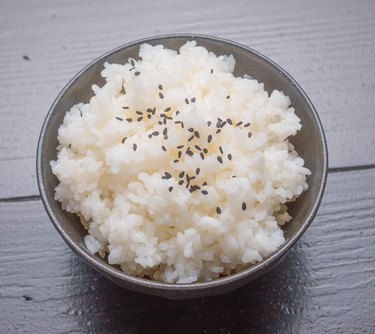
Cooking rice can be tricky. It's hard to gauge how much uncooked rice translates to a serving of rice and the rice-to-water ratio you need to hit the sweet spot between dry and mushy. Once you get the proportions right, though, you'll be all set.
The Rice-to-Water Ratio
Video of the Day
A serving of rice is the equivalent of a half-cup of cooked rice, according to the American Heart Association. So to make two servings of rice, you need to make 1 cup of cooked rice.
Video of the Day
An easy way to remember the rice to water ratio is the 1-2-3 method. According to Michigan State University, 1 cup of dry rice cooked with 2 cups of water gives you 3 cups or six servings of cooked rice. If you only want to make 2 servings, or 1 cup of cooked rice, you will need one-third of a cup of rice and two-thirds of a cup of water.
Read more: Is Jasmine Rice Healthy?
How to Cook White Rice
Follow these steps to cook white rice for two people. All it takes is practice to get perfect, fluffy rice every single time.
- Start with boiling water: Martha Stewart recommends that you add the rice to the water only once it has boiled. To do this, bring the water to a boil in a saucepan. Stir in the rice and a half-teaspoon of salt. Keep the temperature at medium-high until the water starts boiling again.
- Let the rice cook: Once the water is boiling, bring the heat down to a simmer. Cover the saucepan with a lid and let the rice cook until it is tender and has absorbed all the water. Martha Stewart estimates that it should take around 16 to 18 minutes to cook. When it's done, you should see craters in the rice caused by escaping steam.
- Let it steam: Take the rice off the heat but leave the cover on for 10 minutes, so that it can steam.
- Serve it: Use a fork to fluff the rice before you serve it.
Nutritional Quotient of White Rice
White rice is the trusty sidekick that accompanies dishes like stir-fries and curries. Inexpensive and easy to cook, it is a staple in many parts of the world.
But here's something you should know about white rice. Unlike brown rice, which is a whole grain, white rice is a refined grain. The Harvard T.H. Chan School of Public Health notes that the polishing and refining process strips white rice of its fibrous bran layer and nutritious germ layer, leaving only the starchy, white endosperm.
White rice, therefore, loses the majority of its naturally occurring fiber, minerals, B vitamins and phytochemicals. Although some enriched varieties have some of the iron and B vitamins added back, they have only a fraction of the original nutrition.
The USDA's 2015-2020 Dietary Guidelines or Americans recommends that you replace refined grains with whole grains like brown rice, quinoa and oats. In fact, it is recommended that at least half your daily grain intake should be from whole grains. So while you can sneak in the occasional serving of white rice, if you eat rice regularly you should consider switching over to a whole grain instead.